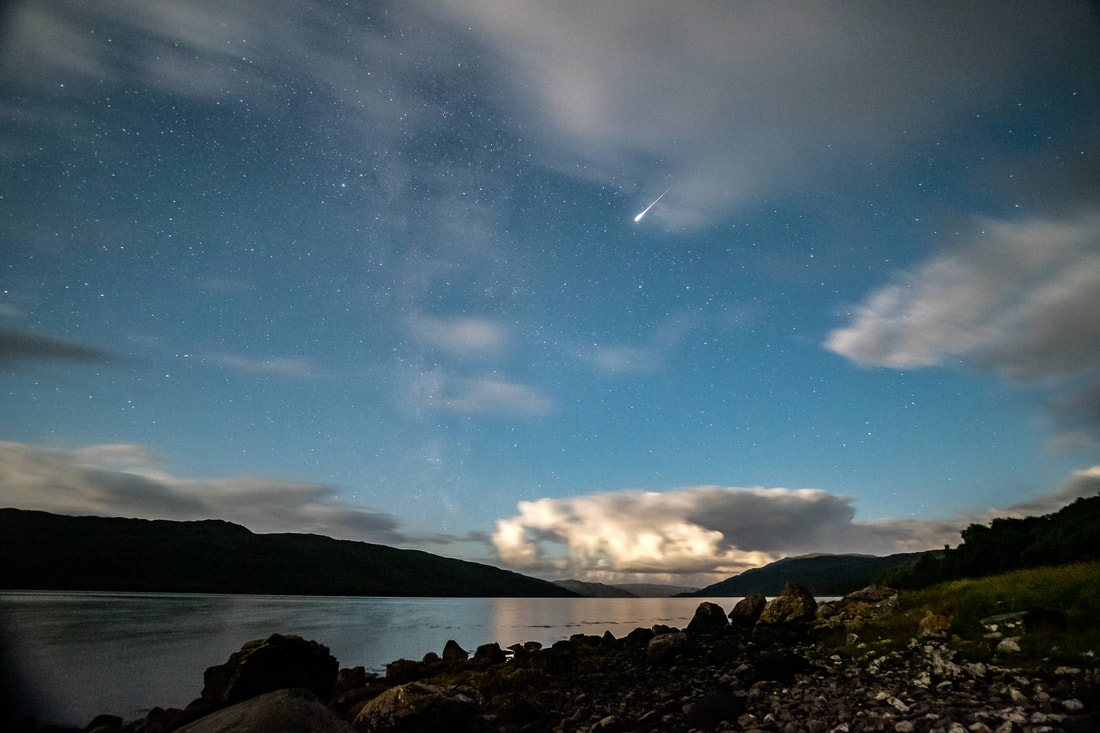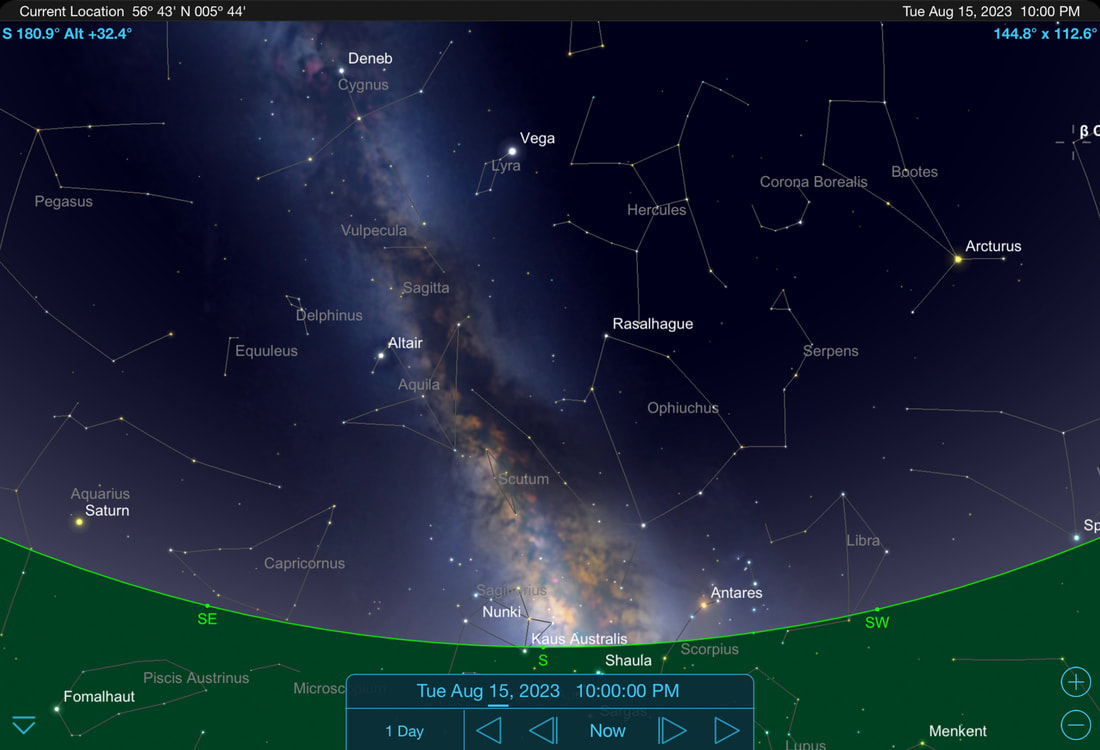|
It’s now August and a few weeks since the Summer Solstice, so you should be noticing it getting dark earlier at night and the stars beginning to appear from about 10pm. Find out how to use the Summer Triangle to navigate your way around them and to also find the cloudy core of the Milky Way. Also find out the best times to look for the two full Supermoons we have this month and for when to watch for shooting stars from the Perseid Meteor shower. The ConstellationsWith sunset now at around 9:00 pm, the stars and the constellations will become visible from about 10:00 pm onwards. As with July, the best way to navigate your way around the night sky is to use the Summer Triangle, which is made up of the three bright stars of Vega, Altair and Deneb. Start off by finding Vega, a bright white star which will be directly overhead. Next is Altair, which you will find halfway between Vega and the southern horizon. Finally, there is Deneb, which will be almost directly above Altair and across from Vega. Once you have found the Summer Triangle, you can now start to look for some constellations. There’s Cygnus the Swan, which is also known as the Northern Cross. It is a large cross-shape with Deneb at the top, marking the tail of a swan which flies down the Milky Way with outstretched wings towards Sagittarius (the Archer) which will be low down on the southern horizon. It’s not a particularly bright constellation, so you’ll need a good clear night and to be far away from any light pollution to see it. When you trace a line between these two constellations, you should be able to make out the Milky Way’s cloudy core, which is the dense and bright region at the centre of our galaxy and home to around 10 billion stars. It will be visible for about two hours after sunset, before dipping below the horizon at around midnight.
Although most of what to see is in the southern night sky, there are a few notable things to see if you look north. In the north-west, you will find the familiar shape of The Plough and you can use its two right hand stars to point towards Polaris (the Pole Star or North Star), which is always in the same position in the sky To the right of Polaris, you’ll see the W-shape of Cassiopeia, the constellation that represents the fabled vain queen of the same name. At this time of year her husband, king Cepheus, is high in the sky, though his stars are nothing like as bright as those of his beautiful wife. Below Cassiopeia are the stars of Perseus, after which the Perseid meteors are named. These meteors will peak on the night of 12-13 August, and you can find out more about them below. Finally, low down and below Perseus is Capella, the brightest star in the constellation of Auriga (the Charioteer) and the sixth-brightest star in the night sky. The MoonWe start the month with the first of two full moons when the Moon becomes 100% full at precisely 7:31 pm on 1 August. This means that it will appear full on the nights of 31 July-1 August, 1-2 August, and 2-3 August. It will rise in the south-east at around 10:00 pm on 31 July, then at around at around 10:30 pm on 1 August and at around 10:45 pm on 2 August. Also, on the nights of 1-2 August and 2-3 August the Moon will be very close to Saturn. This full Moon will pass Earth near to the time it is closest to us in its elliptical orbit, making it a supermoon, or a Sturgeon Supermoon. It is the second of 4 supermoons we have this year with the others occurring on the following dates:
The last quarter Moon (a half-moon) is on 8 August. It will spend the night very close to Jupiter as it travels from east to west. The new Moon (no moon) is on 16 August. This means that a few of days before, on 14 and 15 August, you should see the thinnest of crescent Moons sitting in the north-east before sunrise. This will be from about 3:30 am to 4:30 am. Alternatively, a few days later, on 18 and 19 August, you should be able to pick out the thinnest of crescent Moons sitting low in the western sky as the Sun sets. We have a first quarter Moon (a half-moon) on 24 August. You will find it in the southern western sky, sitting close to Antares and it sets at around 10:30 pm. Unusually, on the night of 30-31 August, a second full Moon, or Blue Moon, will make an appearance. This name does not refer to the Moon's colour, as the Moon usually appears in shades of grey or white. Instead, it refers when two full moons happen within a single calendar month, with the second being called a blue moon. This full Moon will also be a supermoon, making it a Blue Supermoon. It becomes 100% full at precisely 2:35 am on 31 August. This means that it will appear full on the nights of 30-31 August, 31 August-1 September, and 1-2 September. Rising in the east-south-east at around 9:00 pm on each of these three nights, it will be the closest, biggest, and brightest full supermoon of 2023 and a sight well worth looking for. The PlanetsSaturn is visible in the southern sky all night long this month and because it reaches its closest point to Earth on 27 August, it will be shining quite brightly. If you look at it through binoculars or telescope that magnify by about 40 or 50 times, you be able to see its famous rings and its biggest moons. The largest, Titan, is enormous. In fact, it’s 40% more massive than the planet Mercury and 80% more massive than our own moon. To the left of Saturn, you will find Neptune, which is also above the horizon all night long. In contrast to Saturn, it will be quite faint, and you will need a telescope to pick it out from below the stars of Pisces on the southeastern horizon. Jupiter rises in the east at around 11:00 pm, shining brightly and dominating the night sky as it does so. If you look at it through binoculars, you’ll see its four largest moons. They are Io, Europa, Ganymede, and Callisto and are known as the Galilean moons. Uranus will follow Jupiter, rising about quarter an hour later and may be just visible to the naked eye. Venus disappeared from the evening sky towards the end of last month and reappears in the dawn sky in the last week of this month. Rising at around 5:00 am, the Morning Star will be shining about twice as bright as Jupiter and will be the brightest thing in the night sky, apart for the Moon. Mercury and Mars are lost in the Sun’s glare this month. Meteor ShowersAfter a few months’ absence, you’ll be able to see some shooting stars because the number of meteor showers is now on the increase. In fact, August can be a great month for spotting shooting stars because the peak of the annual Perseid Meteor Shower is on the 12-13 August. With the new Moon falling on 16 August, it should be a good year for seeing the Perseids because the Moon will only be a thin crescent and not too bright, so it won’t affect the show too much.
It is called the Perseid Meteor Shower because the radiant (the area of the sky where the meteors seem to originate) is located near the constellation of Perseus and although you can see them throughout the night, you will see more if you wait until this radiant is high in the night sky. This is usually from about midnight until dawn, so watch then to maximise your chances of spotting some shooting stars. Finally, when watching for shooting stars, give yourself at least an hour of observing time, because they will come in spurts, interspersed with lulls. Also remember that your eyes can take as long as 20 minutes to adapt to the darkness of night, so don’t rush the process. If you are patient, you may see up to 60 meteors per hour as the shower’s peak approaches.
0 Comments
|
Steven Marshall Photography, Rockpool House, Resipole, Strontian, Acharacle, PH36 4HX
Telephone: 01967 431 335 | Mobile: 07585 910 058 | Email: [email protected]
Telephone: 01967 431 335 | Mobile: 07585 910 058 | Email: [email protected]
All Images & Text Copyright © 2024 - Steven Marshall - All Rights Reserved






